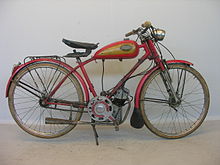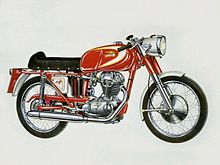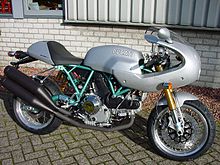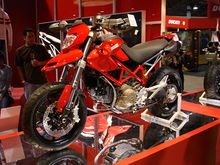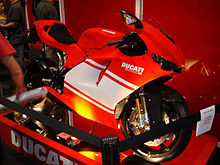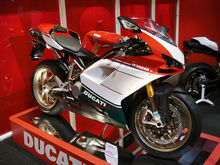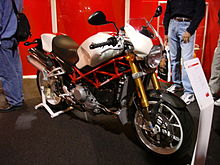- Ducati
-
This article is about the Italian motorcycle manufacturer. For the electrical and electronic component manufacturer, see Ducati Energia.
Ducati Motor Holding S.p.A. 
Type Private[1] Industry Motorcycle manufacturer Founded 1926 Founder(s) Bruno Ducati
Adriano Ducati
Marcello DucatiHeadquarters Bologna, Italy Key people Giampiero Paoli (Chairman)
Gabriele Del Torchio (CEO)Products Motorcycles Revenue  €403.2 million (2008)[2]
€403.2 million (2008)[2]Net income  €32.3 million (2008)[2]
€32.3 million (2008)[2]Employees 1,172 (2008)[2] Subsidiaries Ducati Corse (MotoGP and SBK Superbike racing) Website Ducati.com Ducati Motor Holding S.p.A. is a motorcycle manufacturer in Bologna, Italy. It produces motorcycles for both road use and motorcycle racing.
Contents
History
 The first Ducati logo, 1926—1930s[3]
The first Ducati logo, 1926—1930s[3]
In 1926, three brothers, Adriano, Marcello and Bruno Ducati, founded Societa Scientifica Radio Brevetti Ducati in Bologna to produce vacuum tubes, condensers and other radio components, becoming successful enough by 1935 to construct a new factory in the Borgo Panigale area of the city. Production was maintained during World War II, despite the Ducati factory being a repeated target for Allied bombing.
Meanwhile, at the small Turinese firm SIATA (Societa Italiana per Applicazioni Tecniche Auto-Aviatorie), Aldo Farinelli began developing a small pushrod engine for mounting on bicycles. Barely a month after the official liberation of Italy in 1944, SIATA announced its intention to sell this engine, called the "Cucciolo" (Italian for "puppy," in reference to the distinctive exhaust sound) to the public. The first Cucciolos were available alone, to be mounted on standard bicycles, by the buyer; however, businessmen soon bought the little engines in quantity, and offered complete motorized-bicycle units for sale.
In 1950, after more than 200,000 Cucciolos had been sold, in collaboration with SIATA, the Ducati firm finally offered its own Cucciolo-based motorcycle. This first Ducati motorcycle was a 60 cc bike weighing 98 lb (44 kg) with a top speed of 40 mph (64 km/h) had a 15 mm carburetor giving just under 200 mpg (85 km/L). Ducati soon dropped the Cucciolo name in favor of "55M" and "65TL".
When the market moved toward larger motorcycles, Ducati management decided to respond, making an impression at an early-1952 Milan show, introducing their 65TS cycle and Cruiser (a four-stroke motor scooter). Despite being described as the most interesting new machine at the 1952 show, the Cruiser was not a great success, and only a few thousand were made over a two-year period before the model ceased production.
In 1953, management split the company into two separate entities, Ducati Meccanica SpA and Ducati Elettronica, in acknowledgment of its diverging motorcycle and electronics product lines. Ducati Elettronica became Ducati Energia SpA in the eighties. Dr. Giuseppe Montano took over as head of Ducati Meccanica SpA and the Borgo Panigale factory was modernized with government assistance. By 1954, Ducati Meccanica SpA had increased production to 120 bikes a day.
In the 1960s, Ducati earned its place in motorcycling history by producing the then fastest 250 cc road bike available, the Mach 1.[4][5][6] In the 1970s Ducati began producing large-displacement L-twin (that is, a 90° V-twin) motorcycles and in 1973, released an L-twin with the trademarked desmodromic valve design. In 1985, Cagiva bought Ducati and planned to rebadge Ducati motorcycles with the lesser-known Cagiva name (at least outside of Italy). By the time the purchase was completed, Cagiva kept the "Ducati" name on its motorcycles. In 1996, Texas Pacific Group bought a 51% stake in the company for US$325 million; then, in 1998, bought most of the remaining 49% to become the sole owner of Ducati. In 1999, TPG issued an IPO of Ducati stock and renamed the company Ducati Motor Holding SpA. TPG sold over 65% of its shares in Ducati, leaving TPG the majority shareholder. In December 2005, Ducati returned to Italian ownership with the sale of Texas Pacific's stake (minus one share) to Investindustrial Holdings, the investment fund of Carlo and Andrea Bonomi.
 Ducati logo 1997—2008[7]
Ducati logo 1997—2008[7]
From the 1960s to the 1990s, the Spanish company MotoTrans licensed Ducati engines and produced motorcycles that, although they incorporated subtle differences, were clearly Ducati-derived. MotoTrans's most notable machine was the 250 cc 24 Horas (Spanish for 24 hours).
Ownership
Since 1926, Ducati has been owned by a number of groups and companies:
- (1926–1950) Ducati Family
- (1950–1967) Government IRI management
-
- In 1953 split into Ducati Meccanica-now called Ducati Motor and Ducati Elettronica-now called Ducati Energia
- (1967–1978) Government EFIM management (control over day-to-day factory operations)
- (1978–1985) VM Group
- (1985–1996) Cagiva Group ownership
- (1996–2005) Texas-Pacific Group (US-based) ownership and going public
-
- Headed by CEO Federico Minoli, 1996-2001; returning for 2003–2007
- (2005–2008) Investindustrial Holdings SpA (back in Italian hands)
- (since 2008) Performance Motorcycles SpA (again in Italian hands and going private)[10]
-
- An investment vehicle formed by Investindustrial Holdings, BS Investimenti and Hospitals of Ontario Pension Plan
Motorcycle designs
Ducati is best known for high performance motorcycles characterized by large capacity four-stroke, L-twin (90° twin-cylinder)[11] engines featuring a desmodromic valve design.[12] Modern Ducatis remain among the dominant performance motorcycles available today partly because of the desmodromic valve design, which is nearing its 50th year of use. Desmodromic valves are closed with a separate, dedicated cam lobe and lifter instead of the conventional valve springs used in most internal combustion engines in consumer vehicles. This allows the cams to have a more radical profile, thus opening and closing the valves more quickly without the risk of valve-float, which causes a loss of power, that is likely when using a "passive" closing mechanism under the same conditions.
While most other manufacturers utilize wet clutches (with the spinning parts bathed in oil)[13] Ducati uses multiplate dry clutches in many of their current motorcycles. The dry clutch eliminates the power loss from oil viscosity drag on the engine even though the engagement may not be as smooth as the oil bath versions, and the clutch plates can wear more rapidly.
Ducati also extensively uses the Trellis Steel Frame configuration, although Ducati's MotoGP project broke with this tradition by introducing a revolutionary carbon fibre frame for the Ducati Desmosedici GP9.
Product history
The chief designer of most Ducati motorcycles in the 1950s was Fabio Taglioni (1920–2001). His designs ranged from the small single-cylinder machines that were successful in the Italian 'street races' to the large-capacity twins of the 1980s. Ducati introduced the Pantah in 1979; its engine was updated in the 1990s in the Ducati SuperSport (SS) series. All modern Ducati engines are derivatives of the Pantah, which uses a toothed belt to actuate the engine's valves. Taglioni used the Cavallino Rampante (identified with the Ferrari brand) on his Ducati motorbikes, Taglioni chose this emblem of courage and daring as a sign of respect and admiration for Francesco Baracca, a heroic World War I fighter pilot who died during an air raid in 1918.[14]
1950s
Main article: Ducati Singles1960s
Main article: Ducati SinglesSee also: Ducati Apollo1970s
Main article: Ducati L-twin motorcyclesIn 1973, Ducati commemorated its 1972 win at the Imola 200 with the production model green frame Ducati 750 SuperSport.
Ducati also targeted the offroad market with the two-stroke Regolarità 125, building 3,486 models from 1975 to 1979, but the bike was not successful.[15]
In 1975, the company introduced the Ducati 860GT, designed by noted car stylist Giorgio Giugiaro. Its angular lines were unique, but raised handlebars made for an uncomfortable seating position at high speeds and also caused steering issues.[16]
1980s
Main article: Ducati Desmoquattro motorcyclesDucati's liquid-cooled multi-valve L-twins made from 1985 on are known as Desmoquattro ("desmodromic valve four "). These include the 907i.e., 916 and 996, 999 and a few predecessors and derivatives.
1990s
In 1993, Miguel Angel Galuzzi introduced the Ducati Monster,[17] a naked bike with exposed trellis and engine. Today the Monster accounts for almost half of the company's worldwide sales. The Monster has undergone the most changes of any motorcycle that Ducati has ever produced. After more than a decade of manufacturing, Ducati continues to make innovative changes to this classic motorcycle.
In 1993, Pierre Terblanche, Massimo Bordi and Claudio Domenicali designed the Ducati Supermono . A 550 cc single-cylinder lightweight "Catalog Racer". Only 67 were built between 1993 and 1997.
In 1994, the company introduced the Ducati 916 model designed by Massimo Tamburini,[18] a water-cooled version that allowed for higher output levels and a striking new bodywork that featured aggressive lines, an underseat exhaust, and a single-sided swingarm. Ducati has since ceased production of the 916, supplanting it (and its progeny, the 748, 996 and 998) with the 749 and 999.
2000s
In 2006, the retro-styled Ducati PaulSmart1000LE was released, which shares styling cues with the 1973 750 SuperSport (itself a production replica of Paul Smart's 1972 race winning 750 Imola Desmo), as one of a SportClassic series representing the 750 GT, 750 Sport, and 750 SuperSport Ducati motorcycles.
- Monster 620,695,750,900,S2R, S4R[19]
- ST2, ST3, ST4[19]
- Paul Smart 1000LE, Sport 1000, Sport 1000S, GT 1000 Touring[19]
- SuperSport 750, 900, 1000[19]
- 748, 749[19]
- 996, 998, 999, 1098, 1098S, 1098R[19]
- Desmosedici RR[19]
Current lineup
- 696
- 796
- 1100 Evo
- GT 1000
- 1100
- 796
- 1100 Evo
- 1100 Evo SP
- Streetfighter
- Streetfighter S
Engines
- Desmodue: Desmodromic two-valve air-cooled, 40° included valve angle, (800SS, Multistrada 620, Monster 620 695 696 803 992)
- Desmodue Double Spark: Desmo two-valve, air-cooled, 40° included valve angle, (1000DS, Multistrada 1000, 1000S, Monster S2R 1000, SportClassic GT 1000, Sport 1000, 1000S, Hypermotard 1100, 1100S)
- Desmotre Double Spark: Desmo three-valve, liquid-cooled, 40° included valve angle, (ST3)
- Desmoquattro Testastretta: Desmo four-valve, liquid-cooled, 25° included valve angle, (999, 749, Monster S4R, S4RS)
- Testastretta Evoluzione: Desmo four-valve, liquid-cooled, 25° included valve angle, (848, 1098, 1198)
Motorcycle design history
Ducati (in its various incarnations) has produced several styles of motorcycle engines, including varying the number of cylinders, type of valve actuation and fuel delivery. Ducati is best known for its "L-Twin" motor which is the powerplant in the majority of Ducati-marqued motorcycles. Ducati has also manufactured engines with one, two, three or four cylinders; operated by pull rod valves and push rod valves; single, double and triple overhead camshafts; two-stroke and even at one stage manufactured small diesel engines, many of which were used to power boats, generators, garden machinery and emergency pumps (for example, for fire fighting). The engines were the IS series from 7 to 22 HP air-cooled and the larger twin DM series water- and air-cooled. The engines have been found in all parts of the globe. Wisconsin Diesel even assembled and 'badge engineered' the engines in the USA. They have also produced outboard motors for marine use. Currently, Ducati makes no other engines except for its motorcycles.
On current Ducati motors except for the Desmosedici, the valves are actuated by a standard valve cam shaft which is rotated by a timing belt driven by the motor directly. The teeth on the belt keep the camshaft drive pulleys indexed. On older Ducati motors, prior to 1986, drive was by solid shaft that transferred to the camshaft through bevel-cut gears. This method of valve actuation was used on many of Ducati's older single-cylinder motorcycles – the shaft tube is visible on the outside of the cylinder.
Ducati is also famous for using the desmodromic valve system championed by engineer and designer Fabio Taglioni though they have also used engines that use valve springs to close their valves. In the early days, Ducati reserved the desmodromic valve heads for its higher performance bikes and its race bikes. These valves do not suffer from valve float at high engine speeds, thus a desmodromic engine is capable of far higher revolutions than a similarly configured engine with traditional spring-valve heads.
In the 1960s and 1970s Ducati produced a wide range of small two-stroke bikes, mainly sub-100 cc capacities. Large quantities of some models were exported to the U.S.
Ducati has produced the following motorcycle engine types:
- Single-cylinder,
- pullrod actuated, 48 cc and 65 cc (Cucciolo)
- pushrod actuated, 98 and 125 cc
- two-stroke, 50, 80, 90, 100, 125 cc
- bevel actuated, spring valved: 98 cc, 100 cc, 125 cc, 160 cc, 175 cc, 200 cc, 239 cc, 250 cc, 350 cc, 450 cc
- bevel actuated, desmodromic valved : 239 cc, 250 cc, 350 cc and 450 cc
- belt actuated, desmodromic valved : 549/572 cc Supermono, only 65 made.
- Two-cylinder,
- bevel actuated, spring valved (L-Twin): 750 cc, 860 cc
- bevel actuated, desmo valved (L-Twin): 750 cc, 860 cc, 973 cc (Mille)
- chain actuated, spring valved (parallel twin): 350 cc, 500 cc (GTL)
- chain actuated, desmo valved (parallel twin): 500 cc (500SD)
- belt actuated, desmo valved (L-Twin): Almost all motors since 1986.
- Four-cylinder,
- gear actuated, desmo valved (L-quattro): (Desmosedici)
- pushrod actuated, spring valved (L-4): Prototype Apollo, only two made.
Enthusiasts groups
A key part of Ducati's marketing strategy since the 90's has been fostering a distinct community identity in connection with branding efforts, including online communities, and local, regional and national Ducati enthusiast clubs. There are more than 400 Ducati clubs worldwide, and 20,000 registered users of the Ducati Owners Club web site and 17,000 subscribers to the racing web site.[29] Enthusiasts and riders are informally referred to in the motorcycling community as Ducatista (singular) or Ducatisti (plural).
In North America there are several Ducati enthusiasts organizations, with varying degrees of factory sponsorship. DESMO, the Ducati Enthusiast Sport Motorcycle Organization, is a North American group affiliated with the factory Desmo Owners Club.[30] Some groups are focused on vintage Ducatis,[31] while several are based primarily or entirely on email discussion lists or web forums, such as Ducati.net.[32][33]
Ducati products other than motorcycles
Ducati Meccanica (as the company was previously known) has its marque on non-motorcycle products as well. In the 1930s and 1940s, Ducati manufactured radios, cameras, and electrical products such as a razor. The Ducati Sogno was a half-frame Leica-like camera which is now a collector's item. Ducati and Bianchi (bicycle manufacturer) have developed and launched a new line of racing bicycles.[34]
Currently, there are four Ducati companies: Ducati Motor Holding (the subject of this article), Ducati Corse (which runs the Ducati racing program and is wholly owned by Ducati Motor Holding), Ducati Energia, a designer and manufacturer of electrical and electronic components and systems and Ducati Sistemi, a subsidiary of Ducati Energia. All are located in Borgo Panigale in Bologna, Italy.
Ducati Motor Holding often uses electrical components and subsystems from Ducati Energia.
Merchandising
Ducati has a wide range of accessories, lifestyle products and co-branded merchandise bearing their logos and designs. The company has a licensing agreement with Tumi Inc., launching a collection of eight co-branded luggage pieces in 2006 sold through both of the brands' retail outlets.[35]
Racing history
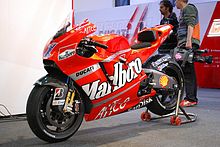 2008 Ducati Desmosedici GP8 (motoGP)
2008 Ducati Desmosedici GP8 (motoGP)
Ducati has a long history with racing, still subscribing to the "win on Sunday, sell on Monday" business model allocating 10% of the companies revenue (approximately $60 million) on racing.[36]
See also: Ducati CorseMotoGP World Championship
Ducati rejoined Grand Prix motorcycle racing in 2003, after a 30 year absence.[37] On September 23, 2007, Casey Stoner clinched his and Ducati's first Grand Prix World Championship.
When Ducati re-joined MotoGP in 2003, MotoGP had changed its rules to allow four-stroke 990 cc engines to race. At the time Ducati was the fastest bike. In 2007, MotoGP reduced the engine size to 800 cc, and Ducati continued to be the fastest with a bike that was markedly quicker than its rivals as was displayed by Casey Stoner on tracks with long straights.
For 2009, Ducati Marlboro Team campaigned their Desmosedici GP9 with former World Champions Casey Stoner and Nicky Hayden.[38] Ducati also supplies customer bikes to the Alice Team, with Mika Kallio and Niccolò Canepa riding for the team in 2009.[39]
Ducati has announced that for the 2011 season, nine-time world champion Valentino Rossi will ride for Ducati Corse.[40][41]
Year Champion Motorcycle 2007  Casey Stoner
Casey StonerDucati Desmosedici GP7 Superbike World Championship (SBK)
For 2009, Ducati will race a homologated version of the 1198. The FIM, the sanctioning body for the Superbike World Championship, has raised the displacement limit for two-cylinder engines to 1200 cc.[42] In 2007, Ducati raced their 999F07 which is a homologated racing version of the 999R because maximum displacement for two-cylinder engines was limited to 1000 cc.
The company has won 13 rider's world championships since the championship's inception in 1988. It has been argued that Ducati has amassed more wins than any other manufacturer because the rules are deliberately set to favour their bikes through manufacturer lobbying; this, of course, is a matter of dispute.[43] In 2006, Troy Bayliss' championship winning 999R was quoted to have 10 to 15 hp less than the Japanese four-cylinder rivals, despite the fact that the Ducati L-Twin had less limitations imposed for tuning its engine(afforded due to the two-cylinder configuration).
Noriyuki Haga finished the 2009 World Superbike season aboard the factory-backed 1098R second overall behind Ben Spies, with 8 wins, and 19 podiums.[44]
Ducati has also won 16 SBK manufacturer world championships for years 1991–1996, 1998–2004, 2006, 2008 and 2009.
British Superbike Championship
The British Superbike Championship has been won by Ducati riders on eight occasions and entered since 1988:
Year Champion Motorcycle 1995  Steve Hislop
Steve HislopDucati 916 1999  Troy Bayliss
Troy BaylissDucati 996 2000  Neil Hodgson
Neil HodgsonDucati 996 2001  John Reynolds
John ReynoldsDucati 996 2002  Steve Hislop
Steve HislopDucati 998 2003  Shane Byrne
Shane ByrneDucati 998 2005  Gregorio Lavilla
Gregorio LavillaDucati 999 2008  Shane Byrne
Shane ByrneDucati 1098 AMA Superbike Championship
In the AMA Superbike Championship, Ducati has had its share of success, with Doug Polen winning the title in 1993 and Troy Corser the following year in 1994. Ducati has entered a bike in every AMA Superbike season since 1986, but withdrew from the series after the 2006 season.[45][46][47]
Year Champion Motorcycle 1993  Doug Polen
Doug PolenDucati 888 1994  Troy Corser
Troy CorserDucati 916 Ducati had an important place in early Superbike racing history in the United States and vice versa: In 1977, Cycle (magazine) editors Cook Neilson and Phil Schilling took a Ducati 750SS to first place at Daytona in the second-ever season of AMA Superbike racing. " Neilson retired from racing at the end of the year, but the bike he and Schilling built — nicknamed Old Blue for its blue livery — became a legend," says Richard Backus from Motorcycle Classics: "How big a legend? Big enough for Ducati to team with Italian specialty builder NCR to craft a limited-edition update, New Blue, based on the 2007 Sport 1000S, and big enough to inspire the crew at the Barber Vintage Motorsports Museum (see Barber Motorsports Park), arguably one of the most important motorcycle museums in the world, to commission Ducati specialist Rich Lambrechts to craft a bolt-by-bolt replica for its collection. The finished bike's name? Deja Blue."[48]
See also
- List of Italian companies
- List of motorcycle manufacturers
References
- ^ Ducati to be delisted after buyout (Reuters). Retrieved 2010-01-21.
- ^ a b c Ducati Motor Holding financial statement FY2008 (PDF) http://www.ducati.com/company/pr_eng_2701_0_3q08_07_08_08_eng_with_tables_-_eng.pdf
- ^ Lodi, Livio (2009). History of the Ducati Logo: The 1920s. Ducati Motor Holding S.p.A.. http://www.ducati.com/heritage/news/storialogo.jhtml
- ^ "Mach 1". ducati.com. http://www.ducati.com/heritage/anni60/mach1/mach1.jhtml. Retrieved 2007-01-25.
- ^ "DUCATI MOTOR HOLDING SPA Annual and Transition Report (foreign private issuer) (20-F) Item 4. Information on the Company". edgar-online.com. 2004-06-30. http://sec.edgar-online.com/2004/06/30/0001156973-04-000783/section5.asp. Retrieved 2008-01-25.
- ^ "History of the Motorcycle". mecossemi.com. http://www.mecossemi.com/H4FrameSet_L.html. Retrieved 2007-01-25.
- ^ Lodi, Livio (2009). History of the Ducati Logo: The 1990s and beyond. Ducati Motor Holding S.p.A.. http://www.ducati.com/heritage/news/storialogo3.jhtml
- ^ The Ducati Bible, Ian Falloon. Books.google.com. 2006-08-10. ISBN 9781845840129. http://books.google.com/books?id=5SiJoP6aevEC&pg=PA12&dq=montano+ducati#PPA10,M1. Retrieved 2010-10-15.
- ^ The Ducati Bible: 860, 900 & Mille, Ian Falloon. Retrieved 2010-01-21.
- ^ chili sv (2008-08-08). "Ducati to be sold to Performance Motorcycles SpA, taken private - Hell For Leather". Hellforleathermagazine.com. http://hellforleathermagazine.com/2008/08/ducati-to-be-sold-to-performan.html. Retrieved 2009-06-14.
- ^ "History of the Two-Valve Twin". Ducati.com. http://www.ducati.com/bikes/techcafe.jhtml?detail=article&value=technical&part=technical&artID=1. Retrieved 2008-01-25.
- ^ "Desmo for Dummies". Ducati.com. http://www.ducati.com/bikes/techcafe.jhtml?detail=article&value=technical&part=technical&artID=2. Retrieved 2008-01-25.
- ^ "What is in an oil". yamaha-motor.ca. http://www.yamaha-motor.ca/our_company/news_item.php?news_id=45. Retrieved 2008-01-25.
- ^ "Fabio Taglioni: a Legend". ducati.com. http://www.ducati.com/heritage/protagonisti/fabiotaglioni6.jhtml. Retrieved 2008-01-25.
- ^ Alan Cathcart (January/February 2011). "Ducati Regolarità 125". Motorcycle Classics. http://www.motorcycleclassics.com/motorcycle-reviews/the-ducati-regolarita.aspx. Retrieved 2011-12-15.
- ^ Roland Brown (July/August 2011). "1975 Ducati 860GT". Motorcycle Classics. http://www.motorcycleclassics.com/motorcycle-reviews/1975-ducati-860-gt.aspx. Retrieved 2011-07-18.
- ^ "Desmo 2 Valve History". monsta.at. Archived from the original on 2007-12-18. http://web.archive.org/web/20071218170044/http://www.monsta.at/site_article_368.html. Retrieved 2008-01-25.
- ^ "Ducati Official History (The 916)". Ducati Motor Holdings. http://www.ducati.com/heritage/anni90/916sbk95/916sbk95.jhtml. Retrieved 2008-06-22.
- ^ a b c d e f g Previous Model Years. Ducati Motor Holding SpA. 2009. http://www.ducati.com/en/bikes/service/archive.jhtml
- ^ Monster. Ducati Motor Holding SpA. 2010. http://www.ducati.com/bikes/monster/index.do
- ^ a b c d e f 2010 Ducati Motorcycles. Total Motorcycle Website. 2010. http://www.totalmotorcycle.com/photos/2010models/2010models-Ducati.htm
- ^ a b c d e f Ducati North America BIKES. =Ducati Motor Holding SpA. 2010. http://www.ducati.com/bikes/index.do
- ^ Multistrada. Ducati Motor Holding SpA. 2010. http://www.ducati.com/bikes/multistrada/index.do
- ^ SportClassic. Ducati Motor Holding SpA. 2010. http://www.ducati.com/bikes/sportclassic/index.do
- ^ "The name is Diavel". Ducati. 2009-12-17. http://www.ducati.com/news/the_name_is_diavel__/2010/10/12/1827/index.do. Retrieved 2010-10-15.
- ^ Superbike. Ducati Motor Holding SpA. 2010. http://www.ducati.com/bikes/superbike/index.do
- ^ BIKES Hypermotard. Ducati Motor Holding SpA. 2010. http://www.ducati.com/bikes/hypermotard/index.do
- ^ Streetfighter. Ducati Motor Holding SpA. 2010. http://www.ducati.com/bikes/streetfighter/index.do
- ^ Jelassi, Tawfik; Leenen, Stefanie (June 27–29, 2001) (PDF). EMBARKING ON E-BUSINESS AT DUCATI MOTORCYCLES (ITALY) [CASE STUDY]. Bled, Slovenia: Global Co-Operation in the New Millennium The 9th European Conference on Information Systems. http://is2.lse.ac.uk/Support/ECIS2001/pdf/040_Jelassi.pdf. "Advertising is also fostered throughthe Ducati web site, which is available in Italian and English; in March 2000, it received on average more than 150,000 hits a day. About 17,000 fans subscribed to the racing site to receive timely press releases and racing results. The Ducati Owners Club site had 20,000 users, after just three months of operations. [...]Over 400 Ducati clubs exist worldwide linking up the Ducatisti Ducati enthusiasts. The company sponsors some of the club activities such as the World Ducati Weekend, which took place in June 2000 at the Misano racetrack, enabling people to race, visit the Ducati factory and the museum in Bologna. Ducati also created the Ducati Desmo Owners Club with its DesmoCard as well as the DesmoNet, Ducati's extranet, connecting dealers with each other and with the factory."
- ^ Desmo Owners Club. Ducati Motor Holding. 2009. http://www.ducati.com/ducatiworld/clubs/home.jsp
- ^ "Ducati Vintage Club Homepage". http://www.ducativintageclub.com/
- ^ "Ducati.net". http://www.ducati.net/
- ^ Duglin Kennedy, Shirley (2005). The Savvy Guide to Motorcycles. Indy Tech Publishing. ISBN 0790613166, 9780790613161. http://books.google.com/?id=kEX7Ncd3hO4C&pg=PA186
- ^ "Bianchi::Ducati Corse". Bianchiducati.com. http://www.bianchiducati.com/. Retrieved 2010-10-15.
- ^ "Tumi Time: Tumi+Ducati Collection". Business Week. 2007-01-24. http://images.businessweek.com/ss/07/01/0124_tumi/source/5.htm. Retrieved 2009-03-28.
- ^ Ducati News Today August, 2009 http://www.ducatinewstoday.com/2009/08/ducati-cuts-production-as-us-sales-decline-by-half/
- ^ "2003 Ducati MotoGP Team". ducati.com. http://www.ducati.com/racing/index_motogp.jhtml. Retrieved 2008-01-25.
- ^ "Hayden to join Stoner at Ducati - Yahoo! Eurosport UK". Uk.eurosport.yahoo.com. http://uk.eurosport.yahoo.com/16092008/58/hayden-join-stoner-ducati.html. Retrieved 2009-06-14.[dead link]
- ^ Pramac Racing October 19, 2008 press release http://www.aliceteam.com/en/news/47_list_news_details/news_detail205.php?id=205&sez=News&id_img=955
- ^ Ducati (15 August 2010). "Rossi to ride for Ducati in 2011 (press release)". MotoGP.com Official Website. http://www.motogp.com/en/news/2010/Ducati+announce+Rossi+deal+for+2011. Retrieved 2010-08-18
- ^ Fiat Yamaha (15 August 2010). "Yamaha and Valentino Rossi to part company at end of 2010 (press release)". MotoGP.com Official Website. http://www.motogp.com/en/news/2010/Fiat+Yamaha+announcement. Retrieved 2010-08-18
- ^ "Changes to the Technical Rules for 2008". worldsbk.com. Archived from the original on 2007-12-18. http://web.archive.org/web/20071218090820/http://www.worldsbk.com/details.php?newsid=1793&lang=eng. Retrieved 2008-01-25.
- ^ "KTM's RC8 superbike targets Ducatis 1098S". gizmag.com. http://www.gizmag.com/ktms-rc8-superbike-has-ducatis-1098s-and-the-2009-world-superbike-crow/9016/. Retrieved 2008-05-23.
- ^ 41 NORIYUKI HAGA. "retrieved 12-21-2009". Worldsbk.com. http://www.worldsbk.com/teams-e-riders/rider?pilota=14. Retrieved 2010-10-15.
- ^ Minoli, Federico (2006-08-22). "AMA Next Year". ducati.com. http://blog.ducati.com/post/65/ama-next-year. Retrieved 2008-01-25.
- ^ Williams, Evan (2007-03-08). "Ducati AMA Superbike Streak Ends". superbikeplanet.com. http://www.superbikeplanet.com/2007/Mar/e/n070308b.htm. Retrieved 2008-01-25.
- ^ Adams, Dean (2006-08-22). "Bombshell: Ducati Pulls Out Of AMA Superbike". Superbikeplanet.net. http://www.superbikeplanet.com/2006/Aug/060822a.htm. Retrieved 2008-01-25.
- ^ January/February 2009 By Richard Backus . "One famous Ducati 750SS". Motorcycleclassics.com. http://www.motorcycleclassics.com/Motorcycle-reviews/One-famous-Ducati-750SS.aspx. Retrieved 2009-07-27.
External links
- ducati.com Official website
- Ducati Motorcycles at the Open Directory Project
- Ducati Associations and Clubs at the Open Directory Project
- Ducati Businesses at the Open Directory Project
Major and notable Italian motorcycle marques Ducati Current motorcycles: 848 · 1198 · 1199 · Diavel · Hypermotard · Monster (696 · 796 · 1100) · Multistrada 1200 · StreetfighterPrevious motorcycles: 60, 60S, 65S · 65T, 65TL, 65TS · 98, 98N, 98T, 98TL, 98S, 98SS · 98TS and 85, 98, 125 Bronco · 125 Aurea · 125 T, TV · Apollo · Mach 1 · 750 GT · 900GTS · Pantah · Paso · 851 · 888 · SuperSport · 916 · 748 · 996 · 998 · 800SS · 749 · 999 · 1098 · Desmosedici RR · ST series · SportClassicDucati mopeds: Other products: Sogno (camera)Designers Ducati Corse racing M400 400 M600 620 695 696 M750 800 S2R800 796 M900 1000 S2R1000 1100 1100EVO S4 S4R Sport 748 749 848 851 888 916 996 998 999 1098 1198 Desmosedici RR Touring / Sport touring ST2 ST3 ST4 Cruisers Indiana Diavel Dual-sport / Off-road Multistrada Hypermotard Categories:- Ducati
- Companies based in Bologna
- Italian brands
- Motorcycle manufacturers of Italy
- Moped manufacturers
- Companies established in 1926
- Private equity portfolio companies
Wikimedia Foundation. 2010.

